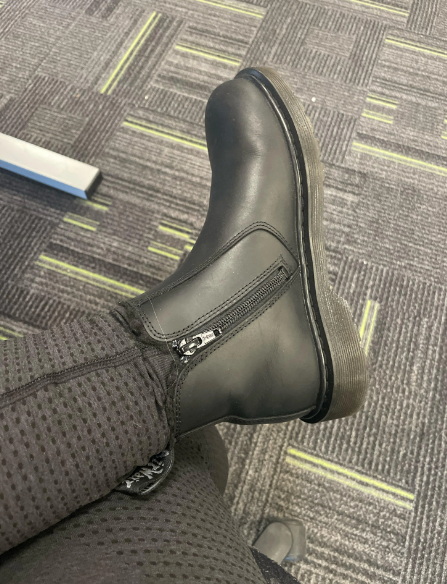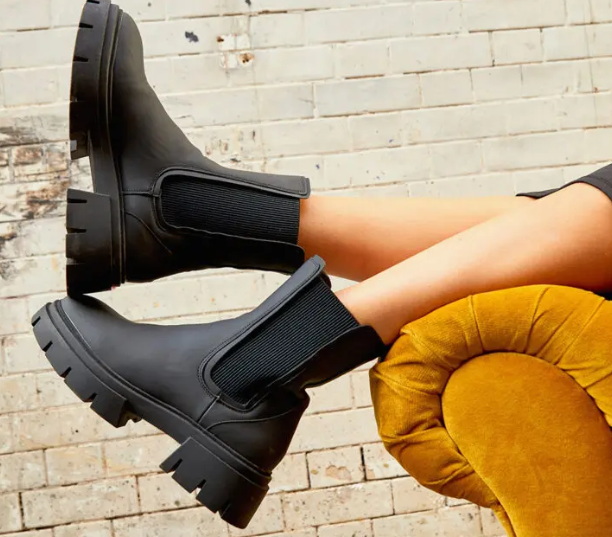Content Menu
● Introduction: The Stylish Challenge
● Understanding the Anatomy of a Chelsea Boot
● Preparing for the Break-In Period
>> 1. Choosing the Right Size:
>> 2. Assessing the Leather:
>> 3. Gathering Essential Supplies:
● Tried-and-True Break-In Methods
>> 1. The Gradual Wear Approach:
>> 2. The Sock Strategy:
>> 3. The Leather Conditioning Technique:
>> 4. The Boot Stretching Method:
>> 5. The Heat Treatment (Use with Caution):
>> 6. The "Stuffing" Technique:
● Addressing Common Problem Areas
>> 1. Heel Discomfort:
>> 2. Toe Box Tightness:
>> 3. Ankle Rubbing:
● Shoe Care During the Break-In Process
● Don'ts of Breaking in Chelsea Boots
● Conclusion: The Rewarding Journey
● FAQ: Your Burning Questions Answered
>> 1. How long does it typically take to break in Chelsea boots?
>> 2. Can I speed up the break-in process?
>> 3. What if my boots are still uncomfortable after several weeks?
>> 4. Is it normal to experience blisters during the break-in period?
>> 5. How do I care for my Chelsea boots after they are broken in?
● Citations:
Introduction: The Stylish Challenge
Chelsea boots are a timeless footwear staple, celebrated for their sleek design and versatility[1][4]. They effortlessly bridge the gap between formal and casual wear, making them a favorite for many. However, the initial stiffness of new Chelsea boots, particularly those crafted from high-quality leather, can pose a significant challenge[1]. Breaking in these boots is essential to achieving the comfortable, personalized fit that makes them a joy to wear. This comprehensive guide provides proven methods, valuable tips, and expert advice to help you navigate the break-in process with ease and minimal discomfort[1][4].

Understanding the Anatomy of a Chelsea Boot
Before diving into the break-in techniques, it's helpful to understand the key components of a Chelsea boot and how they contribute to its overall fit and feel:
- Upper: Typically made from leather (full-grain, top-grain, or suede), the upper forms the main body of the boot. The quality and type of leather significantly impact the break-in process[1].
- Elastic Side Panels: These panels are crucial for the boot's slip-on design and flexibility.
- Lining: The inner lining, often made of leather or synthetic materials, affects comfort and breathability.
- Insole: Provides cushioning and support for the foot. Leather insoles mold to the foot over time, enhancing comfort.
- Outsole: The durable outer layer that provides traction and protection.
- Heel Counter: A stiff component at the back of the boot that provides structure and support to the heel. This area often requires specific attention during the break-in period[6].
Preparing for the Break-In Period
1. Choosing the Right Size:
Selecting the correct size is the most crucial step[13]. A boot that is too small will never break in comfortably, while one that is too large can lead to slipping and blisters. When trying on Chelsea boots, wear the type of socks you plan to wear with them[3][4]. Ensure there is enough room for your toes to move slightly and that the boot fits snugly around the heel and instep. It's always best to try on boots in person, but if that's not possible, check the retailer's return policy[13].
2. Assessing the Leather:
Different types of leather require different break-in approaches[1]. Full-grain leather, known for its durability and rich appearance, generally takes longer to break in than softer leathers like suede or top-grain. Understanding the properties of your boot's leather will help you tailor your break-in strategy.
3. Gathering Essential Supplies:
Having the right tools and accessories on hand can significantly improve your break-in experience[1]. Consider purchasing the following:
- Thick Socks: Provide extra cushioning and protection against friction[2][3][4][10].
- Heel Pads or Cushions: Offer additional padding for sensitive areas like the heel and ankle[1].
- Leather Conditioner: Helps to soften and nourish the leather, making it more pliable[1][7].
- Boot Stretcher: A device that can gently stretch the leather in specific areas[3][14].
- Wonder Balsam: Specifically designed for Dr. Martens boots, this product softens and conditions the leather[1][7].
Tried-and-True Break-In Methods
1. The Gradual Wear Approach:
This is the most recommended and gentle method for breaking in Chelsea boots[2][4]. It involves wearing the boots for short periods and gradually increasing the wear time as the leather softens and molds to your feet.
- Day 1-3: Wear the boots for 1-2 hours at home, wearing thick socks[2]. Pay attention to any areas of discomfort or pressure points.
- Day 4-7: Increase wear time to 3-4 hours, alternating between indoor and outdoor use[2].
- Day 8-14: Wear the boots for longer periods, such as a half-day or a short outing[2]. Continue to monitor your feet for any signs of blisters or excessive rubbing.
- Day 15 onwards: Gradually increase wear time until the boots feel comfortable for all-day wear[2].
2. The Sock Strategy:
Wearing thick socks is a simple yet effective way to stretch the leather and protect your feet from friction[2][3][4][10]. Opt for wool or padded socks that provide ample cushioning.
- Double Socks: For extra stretching, try wearing two pairs of socks[1][3]. This can help to accelerate the break-in process, but be mindful of potential discomfort.
- Damp Socks: Lightly dampen your socks before wearing the boots[5]. The moisture can help the leather to stretch and mold to your feet more easily. However, avoid soaking the socks, as excessive moisture can damage the leather.
3. The Leather Conditioning Technique:
Applying a leather conditioner can significantly soften the leather and make it more pliable[1][7]. Choose a high-quality conditioner specifically designed for the type of leather used in your boots.
- Application: Apply a small amount of conditioner to a clean cloth and gently massage it into the leather[1]. Pay particular attention to areas that feel stiff or prone to rubbing.
- Drying: Allow the conditioner to absorb into the leather for several hours or overnight[1].
- Buffing: Buff the leather with a clean cloth to remove any excess conditioner and restore its shine[1].
4. The Boot Stretching Method:
A boot stretcher can be used to gently stretch the leather in specific areas, such as the toe box or instep[3][14]. This method is particularly helpful for addressing localized areas of discomfort.
- Insertion: Insert the boot stretcher into the boot, ensuring it is properly aligned[14].
- Expansion: Turn the handle of the stretcher to gradually expand the leather[14]. Avoid over-stretching, as this can damage the boot.
- Duration: Leave the stretcher in place for 8-24 hours, depending on the severity of the stretching required[14].
- Removal: Remove the stretcher and try on the boot. Repeat the process if necessary.
5. The Heat Treatment (Use with Caution):
Applying heat can make the leather more pliable and easier to mold[1]. However, this method should be used with extreme caution, as excessive heat can damage the leather.
- Hair Dryer: Use a hair dryer on a low heat setting to gently warm the leather[14]. Focus on specific areas that need stretching, such as the heel or toe box. While wearing thick socks, flex your feet, massage the boots, and allow the leather to cool while it is still on your feet.
- Warm Room: Place your boots in a warm room (not directly in front of a heater) for a few hours[1]. The gentle heat can help to soften the leather without causing damage.
6. The "Stuffing" Technique:
When you're not wearing your boots, stuff them with newspaper, shoe trees, or even cans to help stretch the leather and maintain their shape[1][7][9]. This is a passive method that can supplement other break-in techniques.
- Material: Use crumpled newspaper, shoe trees, or other soft materials to fill the boots completely[1].
- Duration: Leave the stuffing in place overnight or for several days[1].

Addressing Common Problem Areas
1. Heel Discomfort:
The heel counter is a common source of discomfort during the break-in period[6]. To address this:
- Heel Pads: Insert heel pads or cushions to provide extra padding and reduce friction[1].
- Malleable band-aids: Apply band-aids to the back of your heel before you feel a blister forming.
- Massaging: Gently massage the heel counter with your hands to soften the leather[1][10].
- Wonder Balsam: Apply Dr. Martens Wonder Balsam to the inside of the heel counter to soften the leather[1][7].
2. Toe Box Tightness:
If the toe box feels too tight, try the following:
- Boot Stretcher: Use a boot stretcher to gently stretch the toe box[3][14].
- Thick Socks: Wear thick socks to create more space in the toe box[2][3][4][10].
- Stuffing: Stuff the toe box with crumpled newspaper or other soft materials to stretch the leather[1][7][9].
3. Ankle Rubbing:
The top of the boot can sometimes rub against the ankle, causing discomfort. To alleviate this:
- Higher Socks: Wear socks that extend above the top of the boot to protect your ankle.
- Padding: Apply moleskin or other padding to the inside of the boot where it rubs against your ankle.
Shoe Care During the Break-In Process
Proper shoe care is essential during the break-in period to maintain the quality and appearance of your Chelsea boots[1].
- Cleaning: Wipe down the boots with a damp cloth after each wear to remove dirt and debris.
- Conditioning: Apply a leather conditioner regularly to keep the leather soft and supple[1][7].
- Polishing: Use a shoe polish to maintain the shine and protect the leather from the elements.
- Storage: Store the boots in a cool, dry place away from direct sunlight. Use shoe trees to help maintain their shape.
Don'ts of Breaking in Chelsea Boots
- Don't Submerge in Water: Soaking your boots in water is not a good idea[13]. Although it sounds counterintuitive, water can dry out your leather boots, eventually leading to greater problems like cracks and tears.
- Don't Use Extreme Heat: Avoid putting your boots in the oven or using a heat gun[2][13][14]. Excessive heat can damage the leather and cause it to crack.
- Don't Wear for Too Long Initially: Start with short periods of wear and gradually increase the time as the boots become more comfortable[2][4].
- Don't Ignore Pain: If you experience significant pain or blisters, stop wearing the boots and try a different break-in method[11].
- Don't Expect Instant Results: Breaking in leather boots takes time and patience[1][4]. Don't get discouraged if you don't see results immediately.
Conclusion: The Rewarding Journey
Breaking in a pair of Chelsea boots requires patience, persistence, and the right techniques[1][4]. By following the methods outlined in this guide, you can transform your stiff, new boots into a comfortable, personalized pair that will last for years to come. Remember to prioritize your comfort, listen to your feet, and enjoy the journey of creating a unique bond with your Chelsea boots[4].

FAQ: Your Burning Questions Answered
1. How long does it typically take to break in Chelsea boots?
The break-in period varies depending on the type of leather and how often you wear the boots[1][8]. Generally, it takes 2-3 weeks of regular wear to fully break in a pair of Chelsea boots[8].
2. Can I speed up the break-in process?
Yes, you can expedite the process by using techniques such as wearing thick socks, applying leather conditioner, and using a boot stretcher[1][3][7][14]. However, avoid using extreme methods like submerging the boots in water or applying direct heat, as these can damage the leather[13].
3. What if my boots are still uncomfortable after several weeks?
If your boots remain uncomfortable after several weeks of wear, consider consulting a professional cobbler[14]. They may be able to stretch the leather or make other adjustments to improve the fit.
4. Is it normal to experience blisters during the break-in period?
Yes, it is common to experience some blisters or rubbing during the initial break-in period[1][11]. However, you can minimize discomfort by wearing thick socks, using heel pads, and gradually increasing wear time[1][2][3][4][10].
5. How do I care for my Chelsea boots after they are broken in?
Once your boots are broken in, continue to care for them by cleaning them regularly, applying leather conditioner, and storing them in a cool, dry place[1]. This will help to prolong their life and maintain their appearance.
Citations:
[1] https://nushoe.com/break-in-dr-martens-chelsea-boots/
[2] https://www.vionicshoes.com/blog/how-to-break-in-leather-boots/
[3] https://www.overlookboots.com/blogs/boots/how-to-break-in-new-boots-the-right-way-dos-and-donts
[4] https://chelseabootstore.com/how-to-break-in-your-chelsea-boots/
[5] https://www.youtube.com/watch?v=TAMXEAFr328
[6] https://theshoesnobblog.com/breaking-in-shoes-your-first-30-days/
[7] https://www.drmartens.com/us/en/guides/how-to-break-in-docs
[8] https://drewsboots.com/blogs/news/how-to-break-in-leather-boots
[9] https://www.youtube.com/watch?v=EittaMiKidc
[10] https://www.drmartens.com/uk/en_gb/guides/how-to-care/how-to-break-in-docs
[11] https://blacktulipstudio.com/blogs/the-slow-roast/how-to-break-in-new-ankle-boots-painlessly
[12] https://www.youtube.com/watch?v=DPHb60sjUi0
[13] https://www.heddels.com/2019/03/dos-donts-breaking-new-pair-leather-boots/
[14] https://www.blundstone.com/how-do-you-break-in-new-boots
[15] https://www.blundstone.com/how-to-break-in-chelsea-boots
[16] https://www.tiktok.com/discover/how-to-break-in-chelsea-boots
[17] https://www.clarks.com/en-gb/editorial/how-to-break-in-new-shoes
[18] https://www.reddit.com/r/DocMartens/comments/y1811p/chelsea_boot_breakin_help/
[19] https://www.tiktok.com/discover/how-to-break-in-doc-martens-chelsea-boots
[20] https://www.instagram.com/thechelseabootstore/p/DEPYOtltzNp/
[21] https://www.timberland.co.uk/en-gb/customer-care/product-faqs/how-to-stretch-and-soften-leather-footwear
[22] https://www.rollingstone.com/product-recommendations/lifestyle/how-to-break-in-doc-martens-1234995402/
[23] https://www.youtube.com/watch?v=WYJdIsf0Ckk
[24] https://www.nylon.com/fashion/dr-martens-breaking-in-easy
[25] https://www.airr.com.au/2023/11/10/how-to-break-in-chelsea-boots/

















